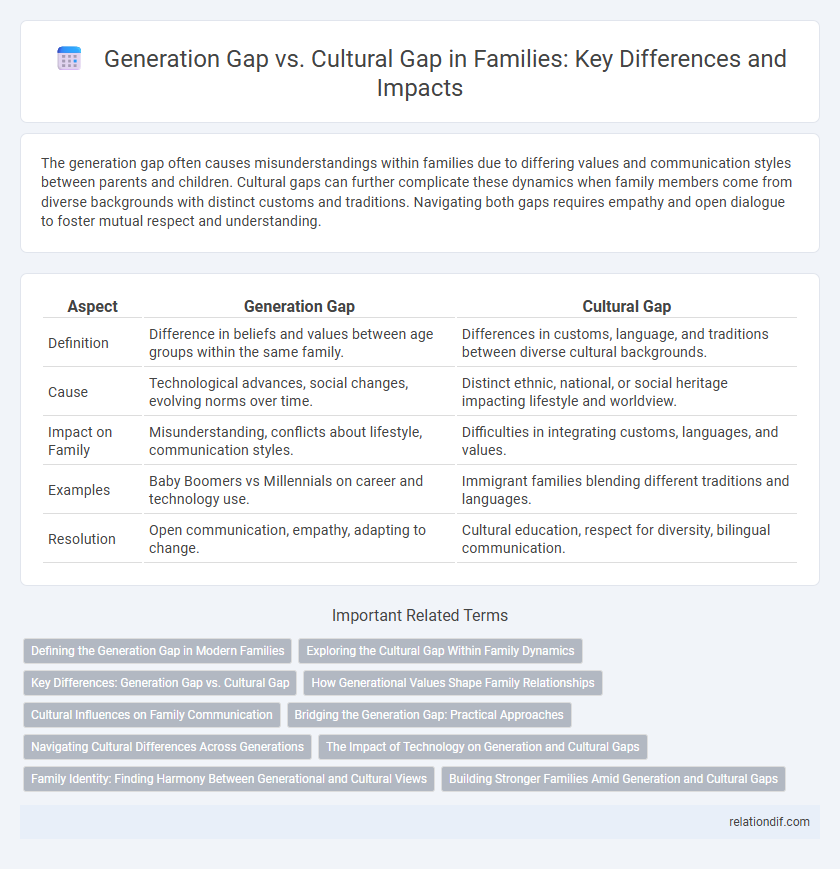The generation gap often causes misunderstandings within families due to differing values and communication styles between parents and children. Cultural gaps can further complicate these dynamics when family members come from diverse backgrounds with distinct customs and traditions. Navigating both gaps requires empathy and open dialogue to foster mutual respect and understanding.
Table of Comparison
| Aspect | Generation Gap | Cultural Gap |
|---|---|---|
| Definition | Difference in beliefs and values between age groups within the same family. | Differences in customs, language, and traditions between diverse cultural backgrounds. |
| Cause | Technological advances, social changes, evolving norms over time. | Distinct ethnic, national, or social heritage impacting lifestyle and worldview. |
| Impact on Family | Misunderstanding, conflicts about lifestyle, communication styles. | Difficulties in integrating customs, languages, and values. |
| Examples | Baby Boomers vs Millennials on career and technology use. | Immigrant families blending different traditions and languages. |
| Resolution | Open communication, empathy, adapting to change. | Cultural education, respect for diversity, bilingual communication. |
Defining the Generation Gap in Modern Families
The generation gap in modern families refers to the differences in attitudes, values, and behaviors between parents and children shaped by distinct technological advancements and social norms. Unlike the cultural gap, which arises from ethnic or societal traditions, the generation gap centers on evolving lifestyle choices and communication styles influenced by digital innovation. Understanding this gap requires analyzing how each generation adapts to rapid changes in technology, education, and global connectivity within the family dynamic.
Exploring the Cultural Gap Within Family Dynamics
The cultural gap within family dynamics often creates divergences in values, traditions, and communication styles between generations. This gap influences conflict resolution and emotional expression, shaping how family members relate to one another across cultural boundaries. Understanding cultural differences enhances empathy and cohesion, fostering stronger intergenerational relationships despite varying cultural backgrounds.
Key Differences: Generation Gap vs. Cultural Gap
The generation gap primarily arises from differences in age-related experiences, values, and technological familiarity between younger and older family members, leading to varying perspectives on lifestyle and communication. In contrast, the cultural gap stems from distinct cultural backgrounds, traditions, and social norms that influence family beliefs and behaviors across different ethnic or national groups. Understanding these key differences is essential for fostering empathy and effective communication within diverse family settings.
How Generational Values Shape Family Relationships
Generational values profoundly influence family relationships by shaping communication styles, expectations, and conflict resolution approaches between age groups. While the generation gap focuses on differences in attitudes and behaviors rooted in the era of upbringing, the cultural gap highlights divergences in traditions and practices that transcend time. Understanding how generational values impact family dynamics enables improved empathy and stronger intergenerational bonds.
Cultural Influences on Family Communication
Cultural influences shape family communication patterns by determining language use, traditions, and values, often creating differences in interaction styles and conflict resolution. These cultural nuances affect how respect, authority, and emotional expression are conveyed across generations, sometimes leading to misunderstandings that transcend the generation gap itself. Understanding diverse cultural backgrounds enhances empathy and promotes effective dialogue within families navigating both generational and cultural divides.
Bridging the Generation Gap: Practical Approaches
Bridging the generation gap involves fostering open communication and mutual respect between family members of different ages, emphasizing shared values rather than differences. Practical approaches include active listening, encouraging empathy, and creating opportunities for meaningful intergenerational activities that strengthen family bonds. Understanding the root causes of misunderstandings and valuing diverse perspectives can significantly reduce conflicts and build lasting connections.
Navigating Cultural Differences Across Generations
Navigating cultural differences across generations within families requires understanding how values, traditions, and communication styles evolve over time and are influenced by broader societal changes. Generation gaps often highlight differing perspectives on technology, lifestyle, and beliefs, while cultural gaps emphasize distinct ethnic, linguistic, or regional backgrounds that shape family dynamics. Emphasizing empathy, open dialogue, and education about each other's cultural heritage fosters stronger intergenerational relationships and mutual respect.
The Impact of Technology on Generation and Cultural Gaps
Technology accelerates communication but often widens the generation gap as older and younger family members adapt to digital tools at different paces. Cultural gaps intensify when technology exposes each generation to diverse global influences, challenging traditional family values and practices. Family dynamics shift as digital literacy becomes essential for bridging understanding across both generation and cultural divides.
Family Identity: Finding Harmony Between Generational and Cultural Views
The family identity often navigates the complex interplay between generation gap and cultural gap, where differing values and traditions challenge mutual understanding. Recognizing shared experiences and open communication fosters harmony, allowing family members to blend generational viewpoints with cultural heritage. Embracing this dynamic balance strengthens family bonds and preserves a unified sense of identity across diverse backgrounds.
Building Stronger Families Amid Generation and Cultural Gaps
Navigating the generation gap requires recognizing differing values and communication styles shaped by evolving societal norms and technology use. Addressing the cultural gap involves embracing diverse traditions and fostering mutual respect to create an inclusive family environment. Building stronger families hinges on empathy, active listening, and adaptability to bridge these divides and cultivate lasting connections.
generation gap vs cultural gap Infographic

 relationdif.com
relationdif.com